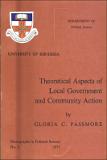| dc.contributor.author | Passmore, Gloria C. | |
| dc.coverage.spatial | Rhodesia | en |
| dc.coverage.spatial | Zimbabwe | en |
| dc.date.accessioned | 2016-03-16T10:25:59Z | |
| dc.date.available | 2016-03-16T10:25:59Z | |
| dc.date.issued | 1971 | |
| dc.identifier.citation | Passmore, G.C. (1971) Theoretical aspects of local government and community action, Monographs in Political Science no.3. Mt. Pleasant, Salisbury: University of Rhodesia. | en |
| dc.identifier.uri | https://opendocs.ids.ac.uk/opendocs/handle/20.500.12413/10089 | |
| dc.description | A study on community development and governance in the rural areas of the then Rhodesia. | en |
| dc.description.abstract | The present study is an attempt to relate community action and local government as two phases of the policy community development in Rhodesia, to international thinking in this field.
The outline is confined to the African rural areas since it was in this section that the policy originated, and where the problems of underdevelopment were most pressing.1 These areas in 1969, comprised some 44,95 million acres or forty-seven percentage of the whole country.2 They housed 3 118 500 or sixty-five percentage of the African and sixty-two percentage of the total population.3 The natural rate of increase among Africans in Rhodesia in 1969 was 3,4 percentage, representing four times the natural rate of growth among other sections. In the same year, the African rural areas produced about thirty-seven percentage of the agricultural output of the country.4
The organisation which prevailed in the African rural areas at the beginning of 1970, was predominantly tribal. There was steady contact, however, with western civilized standards in the towns and cities. Studies had shown that between forty-seven and sixty-five percentage of adult males might be away at any one time on migrant labour.5 Seventy percentage of the African adult population were functionally illiterate.6 By 1970 about eighty percentage of African children were receiving education.7 European- style clothing, brick built homes, transistor radios, tractors and African- owned stores, bore evidence to the changes taking place in the peasant system. The productivity of the tribal lands, however, remained at a subsistence level. The Secretary for Agriculture in his report for 1968 commented that the African rural areas were "not yielding anything like their potential”. The problem was "to change the outlook from a subsistence one to something more progressive”.8
The policy of community development was one of several approaches from which the problem of improving conditions in the African rural areas was being tackled. Other strategies concerned the primary development of underdeveloped districts, the construction of large and small-scale irrigation schemes, and the promotion of industry in these areas. | en |
| dc.language.iso | en | en |
| dc.publisher | University College of Rhodesia. | en |
| dc.relation.ispartofseries | Monographs in Political Science;3 | |
| dc.rights.uri | http://creativecommons.org/licenses/by-nc-nd/3.0/ | en |
| dc.subject | Development Policy | en |
| dc.subject | Governance | en |
| dc.subject | Rural Development | en |
| dc.title | Theoretical aspects of local government and community action | en |
| dc.type | Series paper (non-IDS) | en |
| dc.rights.holder | University of Zimbabwe (UZ) (formerly University College of Rhodesia) | en |


